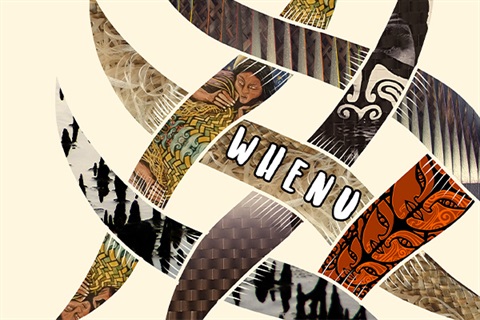Colourful strands of artistic vision – Woven together in Foxton
Published on August 28, 2020

The new ‘Whenu’ exhibition in Te Awahou Nieuwe Stroom is set to raise a few eyebrows – probably in astonishment, as well as admiration – when it opens on Saturday 29 August.
Influences from around the motu and across the sea are woven in new ways into a vibrant kete of diversity – through canvas, fibre, paper, harakeke, wire, a large digital screen and wood.
“Five contemporary artists from around the region have come together, each weaving their innovation and story-telling into one space,” says artist Radha Sahar. “Māori traditions sit alongside European and other influences.”
Debra Bustin, (Ngati Kahungunu), lives in Ōtaki. She is known for her striking and colourful works in the Te Papa collection. Her two large installations, one in woven wire set against natural light, and one anchored in clay footprints, are sure to touch people’s souls, and awaken and inspire them.
Hori from Ōtaki, will feature a video on a large digital screen, flanked by his eye-opening woven canvas work. With his trademark political incorrectness and aroha, he aims to draw attention to important issues, create awareness and open up discussions.
Margaret Hill, a fibre artist from Foxton, weaves using techniques on traditional looms and raranga to make two and three-dimensional woven pieces. Exhibits reflect influences from a recent trip to Japan, NZ flora and the natural colours and textures of her environment.
Charles Bagnall, weaving various worlds together, displays his first Swedish weaving loom (1977) as well as fine furniture, and a variety of arty photographs alongside a ‘photo essay’ from the Transkei, (Nelson Mandela territory) in South Africa, where he lived and worked for two years.
Radha Sahar, from Levin, is known for her three-dimensional twisted and woven canvases. She harkens back to the Celtic traditions of her ancestors, and weaves the present day into harakeke and other natural materials to symbolise the environment and the common threads that bring people together.
“The arts of weaving take us back, into times immemorial,” she says. “Peoples and cultures all over the globe have perfected these skills in so many different ways. Weaving connects us, and joins diverse worlds together.”
“Presenting our works as one, in the Shared Gallery in Foxton, will hopefully inspire a wide range of people. It’s a show where different ideas intertwine – side by side – to create harmony.”
Whenu: From Saturday 29 August to Sunday 11 October
Te Awahou Nieuwe Stroom: Shared Gallery
Open daily – Free entry: 10am – 4pm